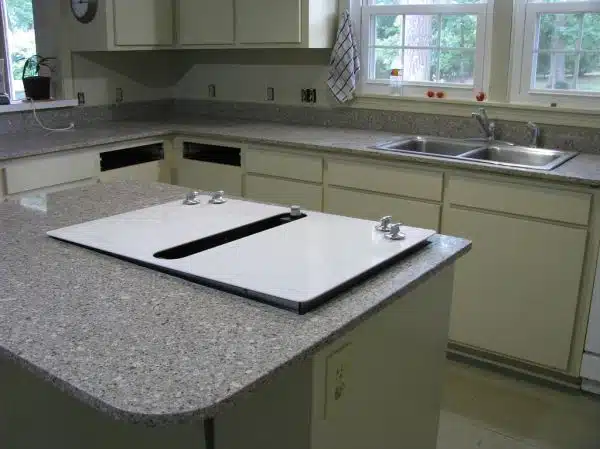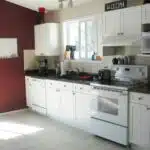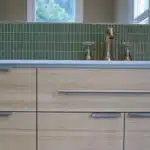When it comes to choosing a countertop overhang, there are several factors to consider. An overhang defines the amount of countertop that extends beyond the base cabinets and can have a significant impact on both the functionality and aesthetics of your kitchen or bathroom. As a renovation expert, I have seen firsthand the importance of selecting an appropriate overhang for your space. In this article, we will explore different types of overhangs, their benefits and drawbacks, and how to choose one that best suits your needs.
The right countertop overhang can make all the difference in creating a functional and beautiful space. Not only does it provide additional seating and work surface area but it also serves as an important design element that can enhance the overall look and feel of your home. However, selecting an appropriate overhang is not always straightforward and requires careful consideration of various factors such as cabinet size, intended use, and personal style preferences. By following some basic guidelines, you can make sure that you choose an overhang that complements your space while also meeting your practical needs.
Understanding The Importance Of Countertop Overhangs
In kitchen design, the importance of overhang cannot be overstated. It serves both functional and aesthetic purposes, making it a crucial element to consider when renovating or building your dream kitchen. An overhang is the amount of countertop that extends beyond the cabinet base or island, which can range from a few inches to a foot or more.
Different kitchen styles call for different overhang options. For example, a modern kitchen may benefit from a sleek and minimalistic overhang, while a traditional kitchen may require a more ornate design. The type of overhang also depends on the function of the space – if it will be primarily used for cooking or entertaining, you may want to select an overhang that can accommodate seating.
Ultimately, the choice of countertop overhang comes down to personal preference and practicality. It’s important to consider factors such as ease of cleaning, durability, and safety when deciding on the right option for your home. In the following section, we’ll delve into some common types of countertop overhangs that you can choose from for your kitchen renovation project.
Types Of Countertop Overhangs
Design options for countertop overhangs are plentiful, with many homeowners opting to customize their kitchen islands and counters to suit their needs. A popular choice is the standard overhang, which typically ranges from one to two inches. This type of overhang provides enough space for seating and dining without sacrificing valuable counter space. It’s important to keep in mind that the length of the overhang should be proportional to the size of the island or counter.
Another design option is an extended overhang, which can range from three to twelve inches or more. This type of overhang offers ample space for seating and entertaining but requires additional support underneath. Homeowners should consult with a professional contractor or installer who can advise on proper installation techniques for extended overhangs.
When it comes to installation tips, it’s essential to ensure that the countertop is level before installing any type of overhang. Uneven surfaces can cause the countertop to crack or become unstable, which can lead to expensive repairs down the line. Additionally, homeowners should consider using durable materials such as granite or quartz for their countertops as these materials are less likely to chip or crack under pressure.
Transitioning into our next section about standard overhangs vs. extended overhangs, it’s important to note that both types have their advantages and disadvantages. While standard overhangs offer simplicity and ease of installation, they may not provide enough space for larger families or frequent entertainers. On the other hand, extended overhangs offer ample space but require additional support and careful installation techniques. Ultimately, choosing between a standard or extended overhang will depend on individual needs and preferences.
Standard Overhangs Vs. Extended Overhangs
By choosing the right countertop overhang, you can transform the look and feel of your kitchen or bathroom. When it comes to selecting an appropriate overhang, there are two main categories to consider: standard vs. custom overhangs. A standard overhang is typically 1 to 1.5 inches while a custom overhang can range from 2 to 12 inches.
Standard overhangs are popular because they are inexpensive and straightforward to install. However, if you’re planning on using your countertop for more than just food preparation, then an extended overhang may be worth considering. Benefits of extended overhangs include providing additional space for seating, creating a multi-functional workspace, and adding a stylish element to your kitchen or bathroom.
When deciding between standard vs. custom overhangs, it’s essential to note that extended overhangs require additional support such as brackets or corbels. This extra support ensures that the countertop remains stable and safe for use. If you’re unsure about which option is best for your space, consult with a home improvement expert who can guide you through the decision-making process. Ultimately, by selecting the right countertop overhang, you can enhance both the functionality and aesthetic appeal of your home.
Looking beyond aesthetics is necessary when selecting an appropriate countertop overhang; it’s crucial also to consider what will work best for your lifestyle and needs in terms of functionality. The benefits of an extended countertop allow for ample room for seating as well as catering towards multi-functional use cases such as meal preparation or providing additional storage space under the counter itself with the installation of pull-out drawers or cabinets. With these added features come increased support needs and financial investments; however, if done correctly by reputable professionals with quality materials used throughout construction processes – this investment will pay off in spades for years down the road as it increases both property value and practical usability within your living spaces.
Benefits Of An Overhang
A countertop overhang is a great addition to any kitchen or bathroom. It provides additional space for seating, preparation, and storage, making your space more functional and efficient. There are many design options to choose from when it comes to the size and shape of the overhang. However, before you decide on your preferred design option, it’s essential to weigh the pros and cons of having an overhang.
One of the primary advantages of having a countertop overhang is that it can be used as a dining area or breakfast bar. This feature makes meal preparation more accessible by providing a comfortable place to sit and eat. Additionally, an overhang can protect cabinets and drawers from spills and splatters that happen during meal prep. Finally, it adds a stylish element to your kitchen or bathroom that can make the space feel more inviting.
Another benefit of having an overhang is that it creates additional workspace for food preparation. With extra counter space at your disposal, you’ll have more room for appliances like blenders or food processors without cluttering up your counterspace. An overhang also provides storage solutions for kitchen essentials like pots, pans, and utensils while keeping them within reach when cooking.
In summary, there are many benefits to incorporating a countertop overhang into your home renovation project. From added seating space to increased storage capacity, this feature can provide numerous advantages for homeowners looking for practical solutions in their kitchens or bathrooms.
Transition: While there are many benefits to having an overhang in your countertops, there are also some drawbacks that need consideration before making a final decision about this feature. In the subsequent section, we will discuss these potential drawbacks so you can make an informed choice about whether or not an overhang is right for you.
Drawbacks Of An Overhang
Just as a ship needs to have a clear vision of the horizon to navigate safely, you must also have a clear and concise understanding of the potential risks involved in choosing an overhang. While it can provide numerous benefits such as a more spacious kitchen, additional storage space and counter space, there are also some drawbacks that must be taken into account.
One of the primary concerns with overhangs is their lack of support. Depending on the size and weight distribution of your countertop, an overhang may not be able to hold up under the pressure. This can lead to structural damage and even injury if someone tries to use the overhang for support. Additionally, an overhang can interfere with foot traffic in your kitchen or dining area, causing safety hazards.
If you’re looking for an alternative countertop edge that provides similar benefits without the risks associated with an overhang, consider options such as bullnose or beveled edges. These edges offer a smooth transition from countertop to cabinet, eliminating any potential safety hazards while still providing ample counter space and storage possibilities.
As you weigh your options for choosing a countertop overhang or alternative edge style, don’t forget to take into account your cabinet size considerations. Your cabinets need to be appropriately sized and spaced to accommodate your chosen countertop design. A professional home renovation expert can help guide you through this process and ensure that your new countertops are both functional and safe for everyone in your home.
Cabinet Size Considerations
When choosing a countertop overhang, it is important to consider the depth of your cabinets. A standard countertop overhang is typically around 1 inch, but this can vary depending on the size of your cabinets. If you have deeper cabinets, you may want to consider a larger overhang to create more workspace and ensure that your countertops are in proportion with your cabinetry.
Height considerations are also important when selecting a countertop overhang. The standard height for a countertop is 36 inches off the floor, but this can be adjusted based on the intended use and functionality of the space. For example, if you plan on using bar stools or chairs at your kitchen island, you may want to increase the height of your countertops and extend the overhang accordingly.
Appliance placement and sink location should also be taken into consideration when choosing a countertop overhang. Make sure to leave enough space for appliances such as dishwashers and refrigerators so that they can be opened fully without interfering with the countertop. Additionally, if you plan on installing an undermount sink, you will need to ensure that there is enough space between the sink and the edge of the countertop to prevent water from spilling onto your cabinetry.
Moving forward, it is important to note that cabinet size considerations are just one step in choosing a countertop overhang. Next, we will discuss how intended use and functionality can also play a significant role in selecting an appropriate overhang length for your countertops.
Intended Use And Functionality
While some may think that choosing a countertop overhang is simply a matter of preference, it’s important to consider the intended use and functionality of the space. Designing for durability is key when it comes to choosing an appropriate overhang. Countertops are often used for food preparation and other daily activities, which means they can be subjected to wear and tear over time. A longer overhang may be more suitable for areas that will experience heavy use, as it can provide extra support and protection.
Of course, aesthetics also come into play when selecting a countertop overhang. While practicality should always be a top priority, there’s no reason why you can’t choose an option that also looks great in your space. Consider the style of your kitchen or bathroom – do you prefer clean lines and minimalism, or do you gravitate towards more ornate designs? You’ll want to select an overhang that complements your existing decor while also providing the necessary function.
Ultimately, striking a balance between practicality and aesthetics is key when choosing a countertop overhang. By keeping both factors in mind during the selection process, you’ll end up with a choice that serves your needs well while also looking great in your home. As you move on to considering personal style preferences in the next section, remember to keep these principles in mind as you make your final decision.
Personal Style Preferences
When selecting a countertop overhang, it is important to consider one’s personal style preferences. Colour preferences can range from neutral shades to bold hues, while material preferences can range from natural stone to engineered quartz. Shape preferences are also key when selecting a countertop overhang, as it can affect the overall design aesthetic. Lastly, budget preferences are essential to consider when making a selection, as certain materials may be more expensive than others.
Colour Preferences
When it comes to choosing a countertop overhang, personal style preferences play a significant role in the decision-making process. One aspect of personal style that affects this decision is colour coordination. For those who prefer a cohesive look, selecting an overhang that matches the colour of the cabinetry or flooring can create a seamless appearance. However, for those who want to add some visual interest, contrasting options are available.
Colour preferences can vary greatly from person to person, and there are multiple factors to consider when making this choice. For example, lighter countertops tend to make a space feel more open and bright, while darker countertops create a more dramatic effect. Additionally, some individuals may prefer neutral tones like beige or grey for their countertop overhangs, while others may opt for bold colours like red or blue.
Ultimately, when deciding on a countertop overhang colour preference should be just one factor to consider. Other important considerations include functionality, durability and maintenance requirements of the material chosen for the countertop itself. By taking all these factors into account before making a final decision, homeowners can ensure they choose an overhang that not only fits their personal style preferences but also meets their practical needs in terms of functionality and durability.
Material Preferences
When it comes to home renovation, personal style preferences play a significant role in the decision-making process. One of the key factors that homeowners need to consider is their material preferences for the countertop overhang. The most popular materials used include granite, marble, wood and concrete. Each has its own unique characteristics, and homeowners must weigh these against their personal style preferences to make an informed choice.
Granite and marble are two popular choices for countertop overhangs due to their durability and visual appeal. Granite is known for its natural beauty, durability, and resistance to heat and scratches. Marble offers a classic look with veining patterns that vary from one slab to another. While both materials are similar in many ways, granite tends to be more durable than marble.
Wood and concrete are also becoming increasingly popular options for countertop overhangs due to their versatility and aesthetic appeal. Wood offers a warm and inviting look while being easy on knives and other sharp objects. Concrete countertops have become particularly popular in modern-style kitchens due to their sleek appearance, customization options, durability, and low maintenance requirements.
Overall, when deciding on a material preference for your countertop overhangs, it is important to consider your personal style preferences as well as the practicality of each option. Whether you choose granite or marble or wood or concrete will depend on your budget, lifestyle needs, design preferences and other factors such as maintenance requirements. By taking into account all these factors before making a final decision homeowners can ensure they choose an overhang that not only fits their personal style but also meets their practical needs in terms of functionality and durability.
Material Options For Overhangs
When it comes to choosing a countertop overhang, there are a few factors that should be taken into consideration. Personal style preferences play a big role in this decision, but it’s also important to keep in mind the functional aspects of an overhang. One of the most important considerations is material choice, as different materials offer varying levels of durability and practicality.
Comparing different materials for countertop overhangs can help you determine which one will best suit your needs. Quartz is a popular option for its durability and low maintenance, but it can be quite expensive. Granite is another durable choice that offers a classic look, but it requires regular sealing to prevent staining and damage. Wood is a more affordable option that adds warmth and character to a space, but it isn’t as resistant to scratches and heat as other materials.
Ultimately, the pros and cons of each material should be weighed against personal preferences and budget constraints when choosing an overhang. It’s important to consider how much use the countertop will receive and what types of activities will take place on it. For example, if you plan on using the space for food preparation or cooking, you may want to choose a material that is resistant to stains and heat. If you’re more concerned with aesthetics than practicality, then you may be willing to sacrifice some durability for the sake of appearance.
In the next section, we’ll discuss the process of installing an overhang once you’ve chosen the right material for your needs. It’s important to carefully follow all instructions when doing so in order to ensure that your countertop remains stable and safe for use. By taking these steps into consideration before making your final decision on an overhang, you can ensure that your countertop meets both your functional needs and personal style preferences.
Installing An Overhang
A countertop overhang can add both functionality and aesthetic appeal to your kitchen or bathroom. An overhang provides extra space for seating, food preparation, or storage. It also creates a decorative element that can enhance the overall look of your space. However, choosing the right overhang requires careful consideration of several factors.
One essential factor to consider when installing an overhang is its support. The overhang must be supported adequately to prevent it from collapsing under weight or pressure. There are various options for overhang support, including brackets, corbels, and hidden supports. Each option has its advantages and disadvantages, so it’s crucial to choose the one that suits your needs and budget.
Another factor to consider when choosing an overhang is the decorative options available. Overhangs can be designed in various ways to create a unique look that complements your space’s style and decor. Some popular decorative options include curved edges, waterfall designs, and ornate corbels. Whatever design you choose should not only look great but also provide adequate support for the countertop.
When installing an overhang on your countertop, always ensure that it meets the required safety standards and local building codes. Additionally, accurately measuring for an overhang is crucial to ensure proper installation. In the next section, we’ll discuss how to measure your countertop accurately to determine the appropriate size of your overhang without compromising safety or aesthetics.
Measuring For An Overhang
Before proceeding with the installation of your countertop overhang, it is crucial to measure accurately. A precise measurement ensures that you get the desired result without any issues. To achieve this, you will require some tools such as a measuring tape and a pencil.
Firstly, start by measuring the length of your cabinet. Ensure that you measure from one end to another, including any corners or curves. Secondly, measure the width of your cabinet in the same manner. Lastly, determine how much overhang you want on each side of your countertop. The standard overhang size is between 1-1/2 inches and 12 inches.
To get an accurate measurement, make sure that you take into account any irregularities on your walls or cabinets. It’s also important to note that different materials have varying thicknesses. As such, it’s advisable to consult with a professional if you’re not sure about what size overhang would work best for your space.
Measuring accuracy is key when it comes to choosing an appropriate countertop overhang for your kitchen or bathroom. Taking accurate measurements requires patience and attention to detail. With the right tools and proper guidance from professionals, you can be confident that your countertop will look stunning once installed.
Next section topic: Maintaining Your Countertop Overhang
Maintaining Your Countertop Overhang
After measuring for an overhang, it’s time to choose the appropriate size for your countertop. Consider the purpose of your countertop and how much space you need for tasks such as food preparation or dining. The standard overhang size is between 1 and 1.5 inches, but it’s ultimately up to personal preference.
Maintaining overhang strength is crucial to ensure safety in your kitchen. Avoid placing heavy objects on the overhang, such as pots and pans or leaning on it with excessive force. Over time, the weight can cause the overhang to weaken or even break. Additionally, proper cleaning techniques should be used to prevent damage from harsh chemicals or abrasive materials.
If you notice any signs of damage to your overhang, such as cracks or chips, it’s important to address it promptly. Ignoring the issue can lead to further deterioration and potentially dangerous situations. Depending on the severity of the damage, repairing or replacing an overhang may be necessary. It’s best to consult a professional for advice on how to proceed with fixing the issue properly while maintaining its strength and integrity.
Repairing Or Replacing An Overhang
When it comes to choosing a countertop overhang, there are several factors that need to be considered. A common mistake that homeowners make is selecting an overhang size based solely on aesthetic preference. However, a poorly chosen overhang can lead to structural issues down the line.
Replacing overhangs is a task that should not be taken lightly. Common overhang issues include sagging, cracking, and instability, all of which can compromise the safety of those using the countertops. Additionally, improper installation or repair of an overhang can result in further damage to the surrounding cabinetry or walls.
To avoid these problems, it’s important to follow proper guidelines when repairing or replacing an overhang. Here are four key items to keep in mind:
- Consult with a professional before making any decisions.
- Choose an appropriate size and material for the overhang.
- Ensure proper installation by a qualified contractor.
- Regularly inspect and maintain the overhang to prevent future issues.
By taking these steps, you can ensure that your countertop overhang remains both functional and visually appealing for years to come. Working with a professional can provide valuable guidance during this process and help you achieve the best possible outcome for your home renovation project.
Working With A Professional
When it comes to choosing a countertop overhang, there are a few factors you need to consider. The first thing to determine is the purpose of your overhang. Are you planning on using it for seating or simply for aesthetic purposes? If you plan on using it for seating, you’ll want to ensure that there’s enough space for people to sit comfortably and that the overhang is supported properly.
Next, you’ll want to decide on the size of your overhang. A standard overhang is usually around 12 inches, but this can vary depending on your needs and preferences. Keep in mind that larger overhangs may require additional support, so be sure to discuss this with your contractor.
When it comes to choosing professionals for this project, communication is key. Start by doing your research and finding reputable contractors in your area who specialize in countertop installation. Once you’ve narrowed down your options, schedule consultations with each contractor and be sure to ask plenty of questions. You’ll want to make sure that they understand your vision and have experience working with the materials you’ve chosen.
With all these factors taken into consideration, budgeting for your countertop overhang is the next step. By determining the purpose, size, and professional team for the installation process ahead of time, you can create a realistic budget that includes all necessary materials and labor costs. Remember to factor in any unexpected expenses that may arise during installation so that you’re prepared for anything. Overall, taking the time to plan out every aspect of your countertop overhang project will help ensure its success and longevity.
Budgeting For Your Countertop Overhang
When planning for a countertop overhang, it is important to consider your budget to ensure that you are not overspending. This can be achieved by setting a realistic budget for the project and sticking to it. Additionally, there are several cost-saving tips that you can incorporate into your planning process to ensure that you get the best value for your money.
One way to save on costs is to opt for a DIY option rather than hiring a professional installer. This will not only save you money on labor costs but also give you more control over the project’s outcome. However, it is essential to note that DIY options require some level of expertise and experience in handling tools and materials.
Another way to save on costs is by choosing less expensive materials such as laminate or butcher block. These materials may not have the same durability as granite or marble, but they are still functional and can look great in any kitchen. It is also possible to mix and match materials with different textures and colors, creating an interesting design element while staying within your budget.
To summarize, budgeting for your countertop overhang requires careful consideration of several factors such as material costs, installation fees, and labor expenses. Cost-saving tips such as DIY options and choosing less expensive materials can help keep expenses under control while still achieving a beautiful result. By following these guidelines, homeowners can create their dream kitchen without breaking the bank.
Conclusion
Countertop overhangs are like the cherry on top of a sundae, they add that extra flair and functionality to your kitchen or bathroom. As an expert in home improvement and renovation, it is important to understand the different types of overhangs available and how to choose one that best suits your needs and budget.
Firstly, consider the purpose of your countertop overhang. Are you using it as a breakfast bar or simply for aesthetic appeal? This will determine whether you need a standard or extended overhang. While an extended overhang may provide more space for seating or meal prep, it can also be more expensive and require additional support.
Secondly, think about maintenance and repair. Overhangs can accumulate dirt, grime, and even water damage if not properly cared for. Be sure to budget for regular cleaning and potential repairs down the line.
In conclusion, choosing a countertop overhang is like picking out a piece of jewelry – it should complement your style while also serving a practical purpose. By understanding the various types of overhangs available and working with a professional to install it properly, you can elevate your kitchen or bathroom design while also adding value to your home. Remember to budget accordingly for both installation and maintenance costs so that your beautiful new addition can last for years to come.
Image Credits
- “Countertops” by NatalieMaynor (featured)





























